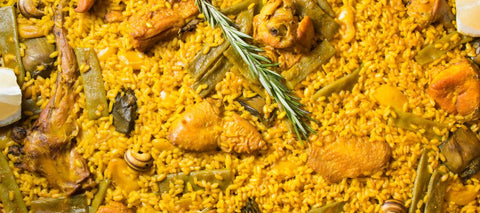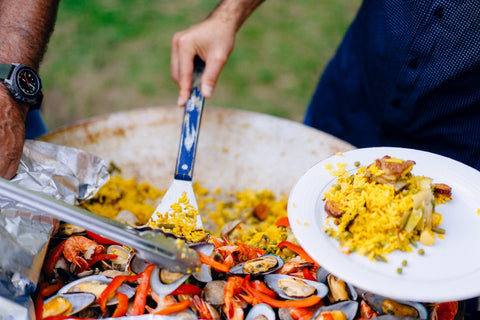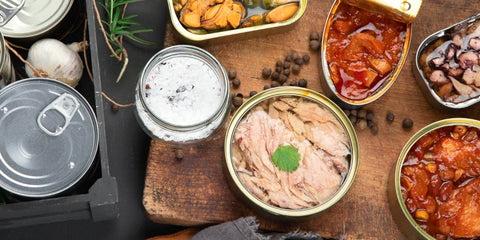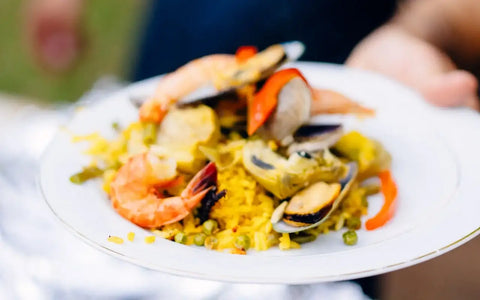Introducción: The Legacy of Rice in Spain
Rice, in its myriad forms and flavors, has found its way into the hearts and kitchens of countless cultures worldwide. Yet, few places have embraced rice with as much passion and culinary artistry as Spain. The history of rice cultivation in this Iberian nation traces back to the 8th century during the period of Moorish rule. The Moors, having honed the skills of rice cultivation from their Persian and Arab predecessors, introduced this precious grain to the fertile lands of the Spanish east coast, particularly the region of Valencia.
Over the centuries, what started as mere cultivation evolved into an integral component of Spain's cultural and culinary identity. Today, Spain isn't just known for its rice fields but for the iconic dishes birthed from them. Among these, paella stands tall as a testament to the nation's love affair with rice. Originating from Valencia, this dish is a harmonious symphony of rice, local ingredients, and flavors, cooked to perfection in wide, shallow pans called "paelleras."
But paella is merely one gem in a treasure trove of Spanish rice dishes. From the creamy delight of 'arroz a banda' to the rich flavors of 'arroz negro' tinted with squid ink, Spanish rice dishes celebrate local ingredients, traditional techniques, and, above all, a history steeped in pride and passion. Today, these dishes are not just meals but memories, stories, and reflections of Spain's age-old traditions and its evolving culinary journey.
With each grain, Spain offers a bite into its history, a taste of its land, and a glimpse into the heart of its people.
The Distinctiveness of Spanish Rice: A Tapestry of Texture, Taste, and Terroir

At the heart of Spain's iconic rice dishes lies a grain that is not just an ingredient, but a symbol of heritage and tradition: Spanish rice. While rice is cultivated and consumed worldwide, the rice from Spain's fields carries a unique signature, and understanding its distinctiveness offers insight into what makes dishes like paella truly special.
-
Texture and Grain Size: Spanish rice, especially the prized Bomba variety, boasts a unique texture and grain size. Unlike the long, slender grains of Basmati or the stickiness of some Asian varieties, Spanish rice grains are short to medium in length, with a firm texture. When cooked, they exhibit a beautiful balance: they remain separate, avoiding mushiness, yet are plump and tender to the bite.
-
Absorption Qualities: One of the standout characteristics of Spanish rice, particularly critical for paella, is its exceptional absorption capacity. It can absorb multiple times its volume in liquid, making it ideal for soaking up rich broths and flavors. This trait ensures that every grain, when cooked in a dish like paella, carries within it a burst of the combined flavors of the ingredients, be it saffron-infused stock, aromatic herbs, or the essence of meats and seafood.
-
Influence of Spain's Climate and Soils: The distinctiveness of Spanish rice is deeply intertwined with the geography of its cultivation. Spain’s varied climate, ranging from the Mediterranean warmth of Valencia to the cooler coastal regions of the north, plays a role in the rice's growth and characteristics. The fertile plains and wetlands, especially areas like the Albufera lagoon in Valencia, provide a combination of freshwater and saltwater, enriching the soil with a unique mineral composition. This terroir imparts a special flavor profile to the rice, impossible to replicate elsewhere.
In essence, Spanish rice is not merely a grain; it's a canvas that captures and presents the rich culinary landscape of Spain. Its texture, absorption qualities, and the very soil and climate it grows in, all come together to produce a grain that is, in many ways, the soul of many a Spanish dish.
Spotlight on Bomba Rice: Valencia's Culinary Gem
In the vast landscape of rice varieties, Bomba Rice, or "Arroz Bomba," shines particularly bright, especially when we venture into the realms of Spanish gastronomy. This rice, deeply embedded in Spain's culinary heritage, carries a legacy as rich as the dishes it graces.
-
Origins of Bomba Rice: Bomba Rice traces its roots to the eastern coasts of Spain, more precisely to the Valencia region. While rice itself was introduced to Spain by the Moors, Bomba emerged as a distinct variety over centuries of cultivation, adapting and evolving in the unique Spanish terroir.
-
What Sets Bomba Apart: At first glance, Bomba rice might seem like just another short-grain variety. However, delve deeper, and its uniqueness becomes evident. Unlike most rice varieties, Bomba expands widthwise when cooked, almost doubling its size. This peculiar behavior gives it a distinct texture - consistently firm yet tender, ensuring it never turns sticky or mushy. This characteristic makes Bomba exceptionally forgiving to cook with, accommodating slight variations in cooking time or liquid without compromising its integrity.
-
Reverence in Paella Making: Bomba's unparalleled absorption capacity is what truly crowns it as the king of paella rice. Capable of absorbing up to three times its volume in liquid, Bomba ensures that every grain is a flavor-packed morsel, making it the preferred choice for paella purists. Whether it's the rich broth, saffron, or the symphony of meats and seafood, Bomba rice captures it all, delivering the authentic taste of Spanish paella in every bite.
-
Cultivation in the Albufera Lagoon: The Albufera, a freshwater lagoon in Valencia, is not just a picturesque spot but also the cradle of Bomba rice. This region, with its mix of freshwater from the lagoon and saltwater from the nearby Mediterranean, provides a unique salinity to the soil. Combined with the region's sunny disposition and age-old rice cultivation techniques, the Albufera ensures that Bomba rice carries a hint of Valencia's soul in every grain.
-
Resilience in Absorbing Flavors: Beyond its texture and structure, Bomba's true magic lies in its ability to act as a sponge for flavors. Its cellular structure allows it to slowly and steadily absorb broths and essences, ensuring a deep, uniform flavor profile. This resilience means that even as it soaks up intense flavors, it maintains its structure, ensuring the perfect bite every time.
In summary, Bomba Rice is not just a culinary ingredient; it's a testament to Spain's passionate affair with rice. Its origins, unique qualities, and the very lands it grows in make it an irreplaceable jewel in the crown of Spanish gastronomy.
Choosing the Right Spanish Rice for Your Culinary Ventures: A Connoisseur’s Guide

As one embarks on the flavorful journey of Spanish cuisine, the pivotal role of rice becomes impossible to overlook. But with the myriad varieties available, how does one choose the perfect grain for their culinary creation? Here's a guide to help you navigate the world of Spanish rice and ensure you're equipped with the best for your dish.
-
The Paella Paradigm: When it comes to paella, few varieties can rival Bomba Rice. Its exceptional ability to absorb flavors, coupled with its consistent texture, makes it the gold standard for this iconic dish. However, if Bomba is out of reach, Calasparra rice can serve as a worthy substitute, bringing its own delicate touch to paella.
-
Creamy Creations: If your aim is to create a lusciously creamy rice dish, akin to the consistency of a risotto, then "Arroz Senia" or "Arroz Bahia" are your best bets. Their starch composition lends itself perfectly to dishes that require a velvety texture, such as 'arroz a banda' or 'arroz caldoso'.
-
Rice for Stuffing: When crafting dishes where rice serves as a filling, like in 'pimientos rellenos' (stuffed peppers), a versatile grain like "Arroz Balilla" is ideal. Its balance of texture and absorption ensures that it complements, rather than overshadows, the other ingredients.
-
Cold Rice Salads: For dishes served cold, like the refreshing 'ensalada de arroz', opt for a rice that maintains its integrity and doesn’t clump together when cooled. A medium-grain variety that doesn’t turn too sticky, such as "Arroz de Pals", will be your ally here.
-
The Authenticity Factor: While the type of rice is essential, the brand's authenticity and origin can make a significant difference. Spanish rice, grown in the traditional regions of Valencia, Murcia, or the Ebro Delta, brings with it the rich heritage of Spanish rice cultivation. Sourcing rice from authentic Spanish brands ensures that you’re not just getting a grain, but a piece of Spanish history and culture. Whether you're a novice cook or a seasoned chef, using genuine, high-quality rice can elevate your dish from good to exceptional.
In the end, the choice of rice can shape the outcome of your culinary venture. By understanding the nuances of each variety and valuing the importance of authenticity, you're not just preparing a dish; you're crafting a culinary experience, rich in tradition and taste.
Crafting Culinary Tales with Spanish Rice
Every cuisine has ingredients that are more than just food; they are the carriers of stories, traditions, and the spirit of a culture. Spanish rice is one such ingredient. With each grain, there lies a story of the sun-kissed fields of Valencia, the time-tested hands of farmers, and centuries of culinary evolution. These grains are not just sustenance but a medium to experience the very soul of Spanish gastronomy.
Spanish rice dishes, from the iconic paella to the comforting 'arroz a banda', are not merely meals. They represent a tapestry of history, geography, and passion, where every bite is a journey through Spain's rich culinary traditions. Each variety of rice, with its unique flavor profile and texture, offers a different tale of tradition and terroir.
As curious palates and passionate cooks, there's a world waiting to be explored – a world where rice is not just a side dish but the star. If you're keen to embark on this flavorful journey, to craft dishes that resonate with authenticity, and to truly understand the heart of Spanish cuisine, then there's no better place to start.
Dive deeper into our collection of genuine Spanish rices at Lespanola. Each variety tells a tale of tradition and terroir, waiting to be a part of your culinary narrative. Embrace the heritage, savor the flavor, and let every dish be a testament to Spain's rich culinary legacy





